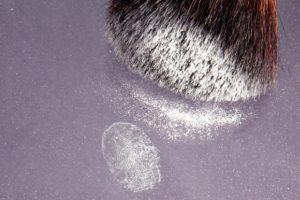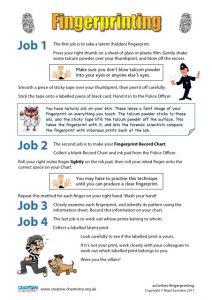Fingerprinting
What's it all about?
In the days before people discovered the value of fingerprinting to identify criminals, mistakes were made when innocent people looked similar to the real felons.
It is easy to take your own fingerprints, though it’s a bit messy with the ink. With enough care, you can find out what sort of fingerprints you have. You can also identify your friends from their fingerprint!
Student notes
There are three parts to the fingerprinting activity:
Taking latent prints
First take a latent (hidden) fingerprint. Press your right thumb on a sheet of glass or plastic film. Gently shake some talcum powder over your thumbprint, and blow off the excess. Make sure you don’t blow the talcum powder into your eyes or anyone else’s eyes.
Smooth a piece of sticky tape over your thumbprint, then peel it off carefully. Stick the tape onto a labelled piece of black card. Hand it in to the Police Officer.

Making a fingerprint record chart
Collect a blank Record Chart (a simple version is shown below) and ink pad from the Police Officer. Roll your index finger lightly on the ink pad, then roll your inked finger onto the correct space on your Chart. You may have to practise this technique until you produce a clear fingerprint.
Repeat this method for each finger on your right hand. Wash your hand!
| Fingerprint record chart | ||||
|---|---|---|---|---|
| Name: | ||||
| Thumb | Index | Middle | Ring | Little |

Comparing fingerprints
Closely examine each fingerprint, and identify its pattern using the information sheet. Record this information on your chart.
Finally, match the prints to their owners. Collect a labelled latent print. Look carefully to see if the labelled print is yours. If it’s not your print, work closely with your colleagues to work out which labelled print belongs to you.

Teacher Guide
Activity notes
This is easy to do, if a bit messy. Only a little talcum powder is needed to get a good result for the latent prints. Make sure that the reverse side of the black card is named, not the front as that would be a bit too easy! Designate a teacher or responsible student as the ‘Police Officer’.
When the students use the ink pad, they should take care to roll their fingers across the paper, otherwise they will only achieve a black smudge.
We found that it was surprisingly easy to deduce the owner of each set of prints (unless they were cheating, of course). If you want to avoid cheating, the ‘Police Officer’ should code the latent prints.
Technician notes
Per group of students:
- 1 × black ink pad (washable ink)
- 1 × roll of sticky tape
- 2 × pieces of black card, approximately 10 cm × 10 cm
- 1 × sheet of clean glass (use propanone for cleaning)
- 1 × container of talcum powder
- 2 × hand lenses
- Fingerprint Record Sheets
![]() Health and Safety
Health and Safety
When considering carrying out a practical activity with a class, you must check your local health and safety rules. Make an appropriate risk assessment and try the activity yourself first.
![]() propanone
propanone
Highly flammable liquid and vapour. Causes serious eye irritation. May cause drowsiness or dizziness. Repeated exposure may cause skin dryness and cracking.
Wear eye protection. Avoid naked flames and other sources of ignition. Dispense in a fume cupboard. Ensure laboratory is well‐ventilated. Avoid skin contact and do not inhale the vapour.

